 Research Article
Research Article
Design and Implementation of Intelligent System for Detection and Analysis of Ebola Disease
Adekunle M Ibrahim* and Selimot Adekanye
Department of Information and Communication Technology, Osun State University, Nigeria
Adekunle M Ibrahim, Department of Information and Communication Technology, Osun State University, Nigeria
Received Date: May 03, 2021; Published Date: May 27, 2021
Abstract
Ebola virus disease is a hemorrhagic fever that has a near 100% fatality rate if not detected on time and properly managed. Between December 2013 and September 6, 2015, Africa and few other countries in the west witnessed the worst outbreak of the disease with 28,183 confirmed cases out of which 11,306 died. In an untiring effort to eradicate this pandemic, scientists have sought different measures for treating and caring for infected persons while also preventing further transmission of the disease. Hitherto, there still exist cases of transmission among humans especially patient-to-health care provider transmission. This project addresses the problem using visual programming language for diagnosing the disease. Requirement gathering exercise and specification was done through interviews with health care providers, site visit to Ebola treatment center and review of literature and Ebola registries. Expert system concepts with Visual Basic programming language were adopted in the development of the system. Reliable inferences were made regardless of the Ebola case scenario that was used in the testing of the expert system. The system showed that reduction in person-to-person transmission of Ebola virus disease can be achieved if probable suspects are identified and diagnosed on time using computer applications that eliminates physical contact with suspects or infected materials and fluids. For confirmed suspects, the system recommends laboratory test as a final proof of the infection. Using an interactive diagnosis expert system for detecting Ebola cases is a fast and safer avenue through which Ebola transmissions; especially human-to-human transmissions could be reduced.
Keywords: Ebola virus; Expert system; Machine learning; Intelligent system and disease detection
Introduction
Background of the study
Ebola virus disease is a rare, infectious and generally deadly viral illness caused by a single stranded, negative-sense RNA virus of the species Zaire ebola virus, which is a type of species for the genus Ebola virus, family Filoviridae, order Mononegavirales with records of high mortality in humans and other primates (Kuhn et al., 2010; Towner et al., 2004). The disease is often sporadic and visibly marked by hemorrhagic fever and severe internal bleeding. Ebola is introduced into the human population through close contact with body fluids of infected animals such as chimpanzees, monkeys, etc. found ill or dead. Ebola then spreads through humanto- human transmission by direct contact (through broken skin or mucus membrane) with bodily fluids of infected people and with surfaces and materials (e.g., bedding, clothing) contaminated with these fluids.
The early symptoms of Ebola known as the ‘dry phase’ is characterized by sudden and intermittent fever, vomiting, general weakness, severe pains especially on the muscles and joints, headache, and sore throat (Brown & ECDC, 2015). Sadly, these early symptoms are intermittent resulting in delay of detection and isolation. Victims and relatives often mistake the signs for cold, malaria and other common ailments already known; hence the increased number of transmissions. The immediate and advanced stage of the virus is marked by more severe bleeding from the nose, gums and skin, bloody vomiting and stools, skin rash and difficulty swallowing (ECDC, 2015).
The outbreak of the Ebola Virus Disease (EVD) in West Africa is the worst epidemic that has befallen African countries in the past decade (Brown, 2015). Many families have been completely wiped out as a result of Ebola deaths while few others have suffered major loss of household members including bread winners. Children are rendered orphans while happy parents are now childless. Between December 2013 and September 6, 2015, Ebola deaths stand at 11,306 out of 28,183 reported cases in 10 countries (Guinea, Liberia, Sierra Leone, Italy, Mali, Nigeria, Senegal, Spain, United Kingdom and United States of America) with Liberia and Sierra Leone having the highest number of reported cases and deaths (WHO, 2015). In an untiring effort to combat this deadly virus, medical professionals have struggled to devise means of fighting the epidemic. In the process, so many have lost their lives.
It is noted that health-care workers are at risk of infection when caring for EVD patients, if they do not wear adequate personal protection equipment (PPE) and if they do not follow strictly, the recommended measures for infection prevention and control. Other risks for workers involved in health care and epidemic response to EVD include psychological distress, stigma, violence, long working hours, heat stress, and dehydration from using heavy personal protection equipment (PPE) and ergonomic problems from handling bodies and loads. These require specific measures for psychosocial support, security and work organization (McCarthy, 2017).
March and Smith (2015) observed that health workers are at the highest risk of being infected with Ebola virus disease even with their protective clothing because they are most certainly the primary contacts to infected patients. This also puts the family members and close associates of health workers at great risk of infection. In addition to the high fatality rate of Ebola virus, some other ailments present similar symptoms, coupled with fear of stigma and social rejection that come to patients and families when a diagnosis of Ebola is confirmed. There is urgent need for effective, accurate and fast diagnosis procedures. This will facilitate early management and quarantine process of infected patients.
ECDC et al. (2015) Showcased that Part of measures put in place by scientists in order to overcome this epidemic is the use of different diagnosis and treatment methods for the disease. Most of the approaches are based on medical laboratory tests and other public health practices; this however does not show reduction in the risk of exposure and transmission. In the light of this, we propose to develop an expert system (a question-and-answer based interactive system) that is capable of giving a timely and reliable diagnosis of the virus. The system must be capable of identifying probable Ebola cases among people who have direct or indirect contacts (exposures) to Ebola victims or infected objects. These include tracking the history of individuals to and from countries with Ebola outbreaks and epidemics and possibly if there is any exposure to Ebola patients, personal contacts, standard of hygiene and hand washing practices. An effective expert system that will leverage the burden and risk of detecting Ebola Virus disease suspects and infected persons is a goal this paper describes.
Statement of the research problems
It is a known fact that the Ebola Virus Disease (henceforth, EVD), is a very contagious and deadly disease. Presently, there is no globally recognized or known cure for the disease. Other problems associated with the disease are:
• What will be the present situation of this deadly disease?
• What will be the design of the intelligent system for the early detection of the disease?
• What is the effect of the implementation of the design system and evaluate the performance of the model?
Aim and objectives
The aim of this study is to develop an Ebola Fuzzy Informatics system for the purpose of diagnosing and provide excellent recommendations to individuals in order to curb the spread of the disease. The specific objectives are:
• to study the present situation of this deadly disease.
• to design intelligence system for early detection of the disease and
• to implement the developed system and evaluate the performance of the model.
Literature Review
Considerable literatures on expert system for medical diagnosis support system have been carried out focusing on one or many diseases. Software systems that possess domain specific knowledge that assist users make better decisions and adopt better strategies are important for the trend of innovation to continue. Past research on ES for medical diagnosis can be broadly classified into the following Rule based, Probabilistic Network (Bayesian network) and Machine learning approach [1].
Ebola virus disease
The Ebola virus disease (EVD), formerly known as Ebola haemorrhagic fever is caused by the Ebola virus of the virus family Filoviridae [2]. It is a dangerous and highly contagious disease with a high fatality rate among infected humans [3]. EVD can be transmitted from both infected animal and humans through direct contact with body fluids including bloody secretions and even the carcass of infected animals such as bush meat, chimpanzees, gorillas, and fruit bats (most of which are delicacies in most affected regions), as well as from humans via direct contact (through broken skin or mucous membranes) with the blood, secretions, organs or other bodily fluids of infected people, and with surfaces and materials (e.g. bedding and clothing) contaminated with these fluids [3,4]. The Ebola virus owes its name to the Ebola River in the present Democratic Republic of Congo where the first Ebola specie was said to have been discovered. Currently, there are five identified species of the Ebola virus, with four being identified to cause disease in humans. They include the Zaire Ebola virus, the Sudan Ebola virus, the Taï Forest Ebola virus, formerly referred to as the Côte d’Ivoire Ebola virus, and the Bundibugyo Ebola virus. The Reston Ebola virus, which is the fifth known specie, has been seen to have caused disease in nonhuman primates only [5].
The most vulnerable groups of people susceptible to the EVD are healthcare workers, due to close contact with infected patients without the sufficient or appropriate use of protective gear and infection control precaution. Other vulnerable groups at risk of infection are family members of infected patients and mortuary attendants, due to a rather close proximity and association with infected persons or their dead bodies. Subsequently, following infection with the Ebola virus, the onset of symptoms occurs after an incubation period of 2 to 21 days, which is the time interval between initial infection with the virus and beginning of signs and symptoms. First symptoms to be expected include the sudden onset of fever, fatigue, muscle pain, headache and sore throat.
This is rapidly followed by vomiting, diarrhoea, rash, and more severe symptoms such as impaired kidney and liver function, internal and external bleeding (e.g., oozing from the gums, blood in the stools) occur in complicated cases [2]. Possible laboratory findings include low white blood cell and platelet counts and elevated liver enzymes. It is important to note that humans are not infectious and cannot transmit the virus until they develop symptoms [6,7].
Since the first outbreak in Nzara Sudan and Yambuku Congo both in 1976, several outbreaks have appeared sporadically in Africa, Gabon, Sudan, Congo and Guinea, accounting for over 885,343 suspected and laboratory confirmed cases of EVD, the disease has resulted in 2,512 fatalities [8].
In addition to chikungunya, dengue, swine flu and zika viral diseases, Ebola virus disease (EVD) is a potential public health threat of pandemic proportions for India. It is so, on account of human-to-human transmission of the Ebola virus via exudates of patients, absence of licenced vaccine(s) for protection against the disease and of therapeutics for the treatment of disease, continued presence of Ebola virus in its reservoir hosts in the endemic areas of EVD, Ebola virus possessing the properties of category – A bio threat pathogen and high fatality rates in its patients. Since 1976 when EVD was first described, there have been at least 26 outbreaks of EVD in the Central and Western regions of Africa. Out of the two recent EVD outbreaks, smaller one in the Democratic Republic of Congo [4], the larger one in West Africa in a region comprising of Guinea, Liberia and Sierra Leone [4] is still in progression and by July 19, 2015, about 11,269 EVD patients had died. Travelers and evacuees from the outbreak region in Africa have carried the disease to Mali, Senegal and Nigeria in Africa and to North America and Europe (en.m.wikipedia.org/wiki/Ebola_virus_e11-11-2014). One infected person or animal can spread the EVD infection in crowded location(s) such that outbreaks thereafter can assume pandemic city. Unless the invasion of EVD is controlled by allround preparedness, EVD in India, if it somehow gets introduced, could rapidly become a pandemic. Preventive measures against the emerging Zika virus disease (ZVD) are being developed using those enunciated against the EVD as the model [9].
However, the current outbreak in West Africa is the largest and most complex Ebola outbreak since the Ebola virus was first discovered in 1976 (Frieden et al., 2014). The current outbreak has recorded more cases and mortality compared to previous outbreaks combined [3,4,10]. It has also spread between countries starting in Guinea then spreading across land borders to Sierra Leone, Liberia, Senegal and Nigeria. So far, the Ebola virus disease is responsible for over 1800 deaths [4].
Another recent work is the creation of paper –based diagnostic test tool for Ebola by James Collins of Boston University USA (Collins,2015). The technology is not an expert system. It uses laboratory processes which majorly deal with embedding sophisticated genetic tests onto piece of paper (Collins,2015). An effective expert system that wills leaverage the burden and risk of detecting Ebola Virus disease suspects and infected persons is a goal this paper describes.
Symptoms of ebola virus disease: Ebola causes a series of symptoms that significantly worsen in a short span of time and may eventually lead to internal and external bleeding that in turn could cause low platelet counts, which can easily threaten the patient’s life [4]. There is currently no proven treatment for EVD, so treatment currently only focuses on supportive care, such as addressing the symptoms to improve the patient’s chance of survival (2016). The common symptoms of Ebola include: Sudden fever, Headache, Joint pain, Muscle pain and Nausea.
Transmission of ebola virus disease: Fruit bats belonging to the Pteropodidae family are thought to be natural EBOV hosts. EBOV is introduced into the human population through close contact with the blood, secretions, organs or other bodily fluids of infected animals such as Chimpanzees, Gorillas, fruit bats, Monkeys, forest antelopes and porcupines. EBOV then gets transmitted humanto- human via direct contact (through broken skin or mucous membranes) with blood, secretions, organs or other bodily fluids of infected people, or indirectly via contaminated fomites. Health-care workers have frequently been infected while treating patients with suspected or confirmed EVD [6].
Intelligent system and medical diagnosis
Intelligence System is the ability of a system to calculate, reason, perceive relationships and analogies, learn from experience, store and retrieve information from memory, solve problems, comprehend complex ideas use natural language fluently, classify and generalize and adapt to new situation.
Alex (2013) diagnosis is a fitting problem area for artificial intelligence where no efficient algorithmic solutions exist, because all the symptoms for all faults are not known in advance. The effectiveness of diagnostic reasoning lies in the ability to infer using a variety of information and knowledge sources, connecting or selecting between different structures to reach the appropriate conclusions (Angeli, 2010). Probabilistic reasoning is the use of the diagnostic value of specific symptoms, signs, or tests to rule in or rule out a diagnosis [11].
Rule based system: Is a set of “if then” statements that uses a set of assertions to which rules on how to act upon those assertions are created. In software development rule-based systems can be used to create software that will provide an answer to a problem in place of human expert
Fred et al. [12] developed an auxiliary diagnosis system that analyzed polysomnographic (PSG) data and provided a medical doctor with diagnosis consistent with the PSG data. The system featured a knowledge-based built with CLIPS (C Language Integrated Production System) and all its features, also a GUI (graphical user interface). Also, it provided the functionality of updating the rules in the knowledgebase after the system has been deployed. The system is heavily platform dependent, and this can limit its usability, since it was built for Windows.
Wiriyasuttiwong & Narkbuakaew [13] proposed a knowledgebased diagnosis expert system that performed inference on signs and symptoms based on production rules and forward chaining that are used in performing inference on a patient’s symptoms. The system showed a high confidence level (99%) on diagnosis of test and validation data. Nevertheless, the system using a fact list of twenty (20) signs and symptoms could be seen as too few a number for diagnosis.
Abu-Naser et al., [14] developed a rule based expert system for the diagnosis of diseases of the endocrine. Knowledge engineering was carried out, and the facts, rules and procedures were built with Java Expert System Shell (JESS) and questionnaire method to collect the symptoms of patients was used. It demonstrated admirable accuracy.
Nevertheless, it had limited accessibility and a limited disease diagnosis as defined in the knowledge base [15], developed a fuzzy medical expert system for the diagnosis of human diseases. It had a rule base that consisted of symbolic rules that were gotten from fuzzification of input data. It was able to capture the uncertainty and ambiguity inherent in diagnosis of diseases and it was also accessible over the internet. Nevertheless, the system had a limited detection rate because of the number of pathological tests it could accommodate per diagnosis of disease in real time.
Borgohain & Sanyal [16] developed a rule based diagnostic expert system that provided diagnosis for cerebral palsy. The system was built with JESS, it provided the user with a questionnaire which the user answered, and the answers were weighted. Diagnosis was performed from rules collected during knowledge engineering process. The output of the system classified according to the severity i.e., mild, moderate or severe. The system didn’t support remote access (i.e., web or internet).
Tunmibi et al., [17] built an expert system for the diagnosis of fever. It was implemented with a rule-base, the rules defined after interviews with medical doctors. The system provided an easily accessible and usable interface and could diagnose a number of fever variations. The system was unable to present a diagnosis with incomplete information, because of the rule-based technique implemented.
Oguntimilehin et al., [18] developed an expert system that will be used for the clinical diagnosis of the various levels of typhoid fever. The LEM2 rule induction algorithm was used for the classification of the patient data. The algorithm generated eighteen (18) unique rules that will classify a symptom into the five (5) categories of typhoid fever.
Hassan [15] developed a fuzzy medical expert system for the diagnosis of human diseases. It had a rule base that consisted of symbolic rules that were gotten from fuzzification of input data. It was able to capture the uncertainty and ambiguity inherent in diagnosis of diseases and it was also accessible over the internet. Nevertheless, the system had a limited detection rate because of the number of pathological tests it could accommodate per diagnosis of disease in real time.
Borgohain & Sanyal [16] developed a rule based diagnostic expert system that provided diagnosis for cerebral palsy. The system was built with JESS, it provided the user with a questionnaire which the user answered, and the answers were weighted. Diagnosis was performed from rules collected during knowledge engineering process. The output of the system classified according to the severity i.e., mild, moderate or severe. The system didn’t support remote access (i.e., web or internet).
Tunmibi et al., [17] the authors built an expert system for the diagnosis of fever. It was implemented with a rule-base, the rules defined after interviews with medical doctors.
Machine learning approach: This is an application of artificial intelligence (AI) that provides systems the ability to automatically learn and improve from experience without being explicitly programmed. It focused on the development of computer programs.
Levine et al., 2015 used logic regression a supervised machine learning algorithm to develop a novel and simple Ebola prediction scoring system for triaging Ebola risk in patients with suspected EVD using EVD testing result of 382 patient’s data collected at Ebola treatment unit in Liberia over a period of 16 weeks of which 160 patients tested positive for EVD. For the Ebola prediction score, 6 symptom-variables independently predictive of laboratoryconfirmed Ebola virus disease was used as against 14 symptoms by WHO, and the result showed that patients with higher Ebola prediction scores had higher probability of laboratory confirmed EVD. The study was able to empirically derive and internally validate a clinical prediction model for laboratory confirmed EVD but was a paper rather than computer-based template.
The system was quite accurate; having a detection rate of 95% on validation data and it could handle categorical and numeric data values. The decision tree was used to generate 17(seventeen), as such the system classification model would be tedious to update, when new information is provided.
Williams & Olatunji [19] proposed hybrid architecture for the diagnosis of typhoid fever using MATLAB. The system used artificial neural networks in tandem with fuzzy logic. The artificial neural network was used to estimate the membership function for the typhoid symptom severity. This provided for a better fit for diagnosis from data. Nevertheless, the system was computationally expensive, requiring superior hardware, the system was also not accessible remotely (i.e., over the web or internet).
System Methodology
Research approach
This chapter covers the methods applied in the accomplishment of Expert System development for diagnosis of Ebola diseases, the medical practitioner will treat the patient since the model had been equipped with necessary methods in classifying patient based on their respective clinical features, it also explains the method of application of Visual Basic to correctly predict patient’s ailment with the provision of patient’s data [20-23].
The design of this Ebola diagnostic Expert System (ES) began with consultations and interviews with public health and research experts at the LAUTECH Teaching Hospital, Osogbo and OAU teaching hospital Ile-Ife, Osun State. From these exercises with information gathered from relevant literatures served as the basis for the development of this research.
Visual Basic 6.0 was chosen as the programming language for the development of this expert system. The reason for choosing this programming language was based on the submission of Rani and Rajesh (2018) that Visual Basic is a rapid application development tools that allows programmers to create simple GUI applications, the language not only allows programmers to create simple GUI applications but can also develop complex applications. Programming in VB is a combination of visually arranging components or controls on a form, specifying attributes and actions of those components, and writing additional lines of code for more functionality [24].
Visual Basic 6.0 is a programming language that is widely used for development of expert systems (Sarma et al., 2017, and Rani & Rajesh, 2016) due to its portability, reliability, user friendly and readily available with any version of Microsoft office which is affordable when compared with other languages. Feigenbaum and Lederberg (2019) describe Visual Basic as a programming language that decreases the percentage of mistakes, it doesn’t call for additional expensive software, VBA is very easy to learn, saves time and money. From the information gathered during the requirement phase, (Rani & Rajesh, 2016) were able to classify the symptoms of an Ebola virus diseases into three, namely the early symptoms, intermediate symptoms and the advanced symptoms.
Data preprocessing
The dataset obtained was unstructured and contains some information’s that are not necessary for this work such as name, patient ID, address, email etc.
The inclusion of these column will render our model more Bucky of words and irrelevant information, therefore there is need for preprocessing a situation where the data was section into respective and useful column most importantly clinical history column that contains all the symptoms to be used in this work, took several weeks to partition same symptoms into column in order to maintain meaningful dataset. This section presents the processes of validating the designed model [25].
Conceptual framework and system design: This shows the diagrammatic representation of the steps involve in the development of an intelligence system to diagnose an Ebola patient (Figure 1).
a. Dataset: This is collection of data from a particular patient, In the case of this research these are data of Ebola patients. It is a table with every column representing a patient data and row corresponds to each patient. Data sets have similar structure. A generalized table structure is described below:
• Fever: It is a temporary increase in body temperature; it shows that things are not right in the body system.
• Headache: It is pain experience in any region of the head.
• Abnormal heart rhythm: This is when the heartbeat too slow, irregular or fast etc.
• Pain: It is an unpleasant sensory and emotional experience associated with actual or potential tissue damage.
• Diarrhea: A situation in which faces are discharged from the bowels frequently and in liquid form.
• Abdominal pain: It is a pain that occurs between the chest and pelvic region.
• Hemorrhage: It is an escape of blood from a ruptured vessel.
• Deaf: The inability to hear.
• Seizure: It is an uncontrolled, sudden, electrical disturbance in the brain.
I. Training Dataset: is a part of data set used in training the model. Majority of the dataset are used in training the model.
II. Classification (building Model): this is a process of organizing the data sets into categories on the basis of training the dataset.
III. Testing Dataset: This is a part of the dataset taken aside for testing our model. After our model has been trained, we test our model by making prediction against the test set.
IV. Trained Model (Knowledge Base): After our model has been trained and tested, our trained model serves as our knowledge base. The knowledge base can also be used to test similar data relating to the dataset used in training the model.
V. Inference: this is the process in which the system reasons using logic rules to deduce information from the knowledge base. The process of inference will be carried out using the decision tree algorithm as a set of logic rules to inference deduce information in the knowledge base.
VI. User Interface: this act as an intermediary between the user and the inference engine. It helps user communicate with the system effectively and it is also a means of feedback to user.
VII. Knowledge-Based System (KBS): is a computer program that reasons and uses knowledge base to solve complex problems. The term is broad and refers to many different kinds of systems. The one common theme that unites all knowledgebased systems is an attempt to represent knowledge explicitly and a reasoning system that allows it to derive new knowledge.
VIII. Extractions: are ways to separate a desired substance when it is mixed with others.
IX. Preprocessed Data: data preprocessing includes clearing instance selection, normalization transformation feature extraction and selection. etc. This product of data preprocessing is the final training set.
Use cases and activity diagram
In software and system engineering, a use case is a list of actions or event step typically define the interactions between a role (known as the unified modeling language (UML) as an actor) and a system to achieve a goal. The actor can be a human or external system [26].
The use cases comprise of the following features:
• Administrator: he/she serves as an intermediary between the system and the patient.
• Patient Data: The most important feature in the development of the system is patient data, it is the symptoms shown by each patient that will enter into the system for processing and classification.
• Prognosis: Prediction is made using the inputted patient data to decide which of the disease the patient is carrying.
• Result: This is the output data of the system, which can be prescribed by the doctor to the patients.
• Primary Health care: This is a place where the infected persons are being treated (Figure 2).
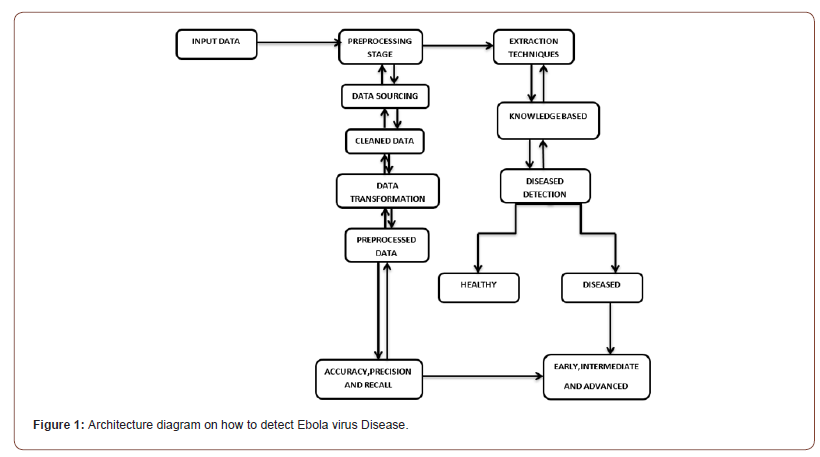
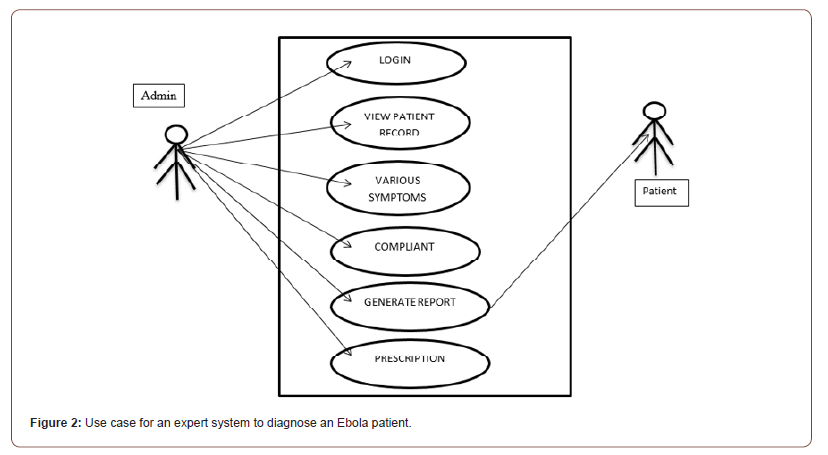
Implementation, Result and Discussion
This section presented the data and its analysis, it also presented the performance metric for the selection of accurate, precise and sensitive model that best predict tendency of the disease.
Data analysis
The proposed system consists of three main sections. These sections are the Knowledge base, The Reasoning, or Inference Engine and The User Interface.
The Knowledge Base: This is an expert system that contains the domain knowledge which is usually provided by the human experts in that domain and translated into rules and strategies. In this study, the design of knowledge base is in form of rule-based, heuristics or probabilities. In a rule-based expert system, the knowledge is represented as a set of rules where each rule specifies a relation, recommendation, directive, strategy or heuristic. IF condition THEN action, is structurally used in this study.
The inference engine: This is the main processing element of the expert system that determines which rule antecedents are satisfied by facts. In order to give valid analysis and inference for a problem, in this study, the Inference engine begins by asking the user questions, applying the questions to facts and relationships in the knowledge base and then draws suggestions, predictions and answers.
The user interface: This fosters the communication between the end user and the expert system. A robust and user-friendly interface which makes interactions so interesting was used in the research work.
Ebola virus diagnosis system
This is used to log in into the system. The entities include User ID and the Password, once the correct User ID and password are input, a message box will be displayed requesting to know the status of the patient either new or old. For a new patient, a new bio data form will prompt on the window in which the new patient has to supply all the necessary bio-data information needed. Such information includes Name, Age, Address, Marital Status, Gender, etc. Also, for an old patient which has been using the expert system before, the existing bio data form of the patient will prompt on the window. The USER ID forms, and Patient Status message box are shown in Figures 3 & 4 respectively.
Patient registration: The input requirements here are the various data fields to be captured from the patient. The data collection interface is user friendly and can capture the patient’s bio data as well as other information needed as can be seen in Figure 5.
Patient investigation: The inputs here are the various data fields to be captured from the patient. The investigation interface captures the patient’s responses to symptoms. This study classified symptoms of Ebola Virus Disease (EVD) into three: the early symptoms, the intermediate symptoms and the advanced systems. A probable suspect is said to show early symptoms of Ebola if his/ her response is ”Yes” (which could be Mild or Severe) to any of the following signs of illness. Example of a patient whose responses are “yes” to all the early symptoms is shown in Figure 6.
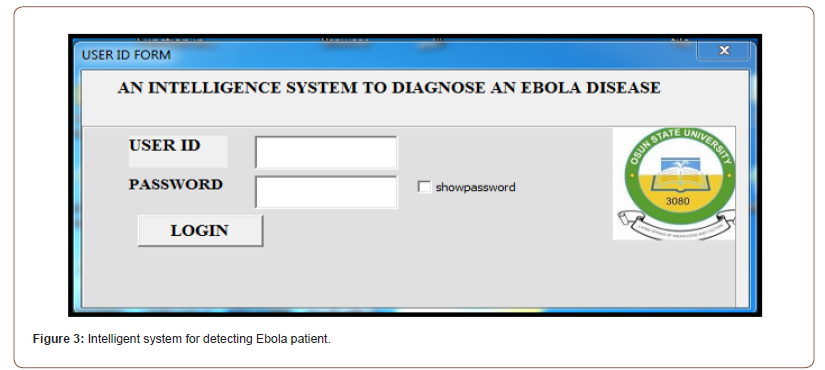
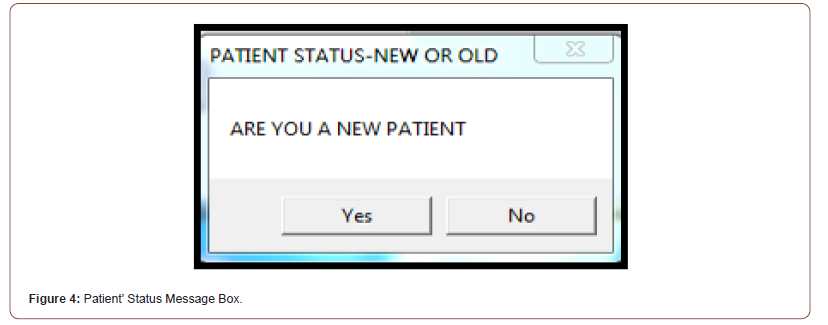
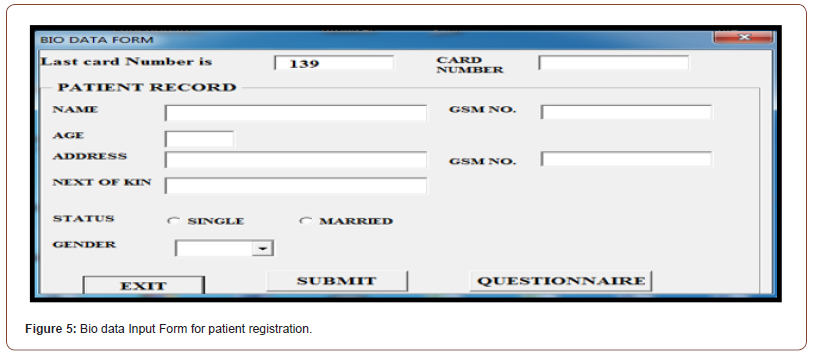

But a probable suspect is said to show no early symptoms of Ebola if it is ”No” that is “Nil” to all of the symptoms, that is headache is selected to be “Nil”, sign of illness is selected to be “Nil”, sore throat is selected to be “Nil” and the muscle or joint pain is also selected to be “Nil”. Example of a patient whose responses are “yes” to all the early symptoms is shown in Figure 7.
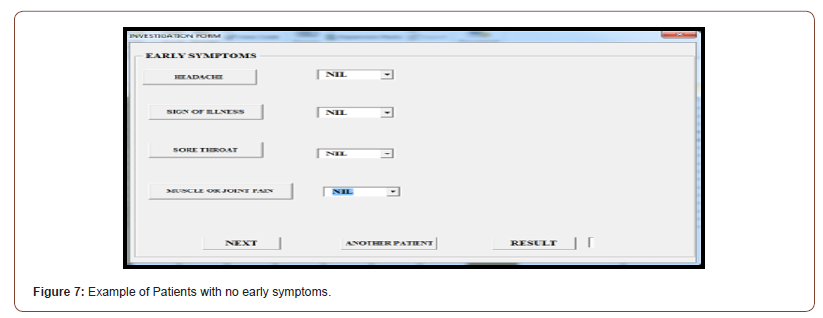
However, a probable suspect is said to show no Advanced symptoms of Ebola if it is ”No” that is “Nil” to all of the symptoms, that is Fever is selected to be “Nil”, Stomach pain is selected to be “Nil”, and Lack of appetite is selected to be “Nil”. Example of a patient whose responses are “Nil” to all the intermediate symptoms is shown in Figure 8.
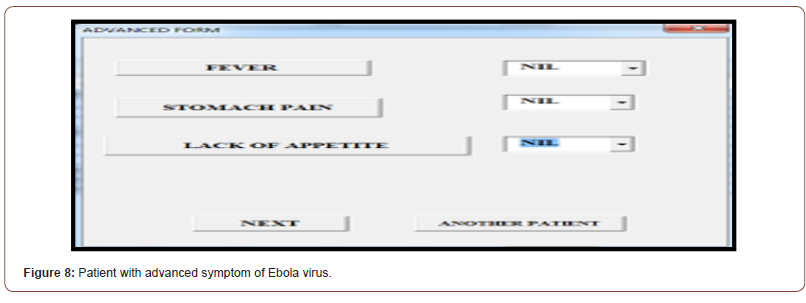
A probable suspect is said to show an advanced symptoms of Ebola if it is ”Yes” that is “Mild or Severe” to any of the symptoms, Example of a patient whose responses are “Yes” to all the Advanced symptoms is shown in Figure 9.
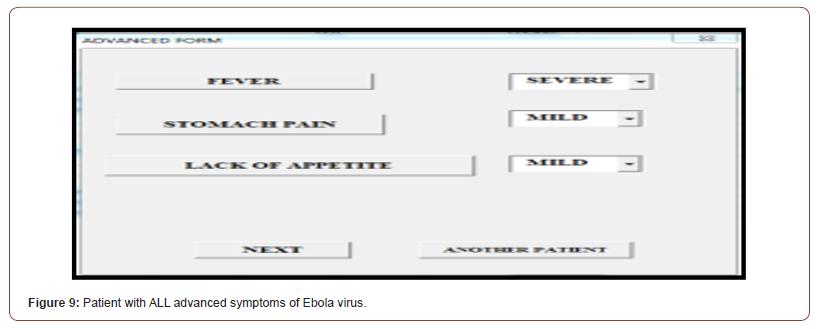
A probable suspect is due for a contact test if all the aforementioned (Early, Intermediate, and Advance symptoms) are positive. The contact test would then be conducted to know if such a patient visited any of the towns where Ebola Virus has been detected and probably made any direct or indirect physical contacts with Ebola Patient. Figure 10 shows example of a patient whose response is yes to visitation to “any of the town where there is Ebola Outbreak in the past 21 days” but could not confirm having direct or indirect physical contact with Ebola patient.
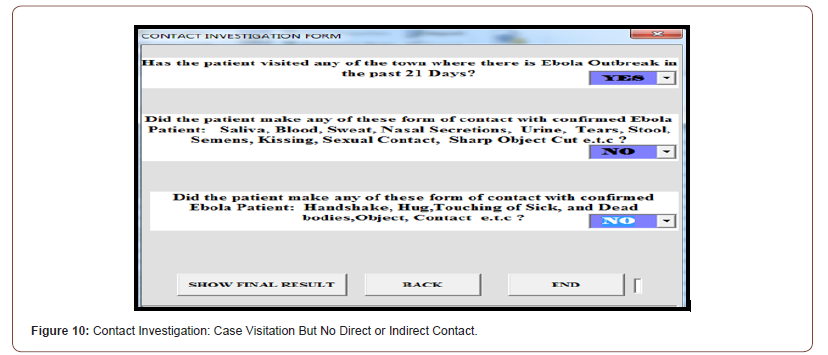
Table 1:Set of rules used in the knowledge based in the form of if then else structure.
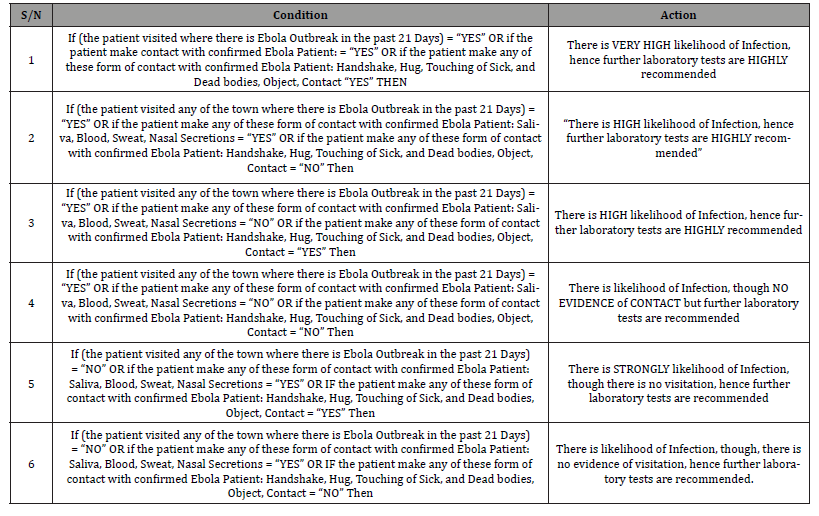

A probable suspect is said to show a contact symptom of Ebola, if the patient makes no visitation to any infected town but one way or the order had contact, directly or indirectly with any confirmed Ebola patient. Example of a patient whose responses is “No” to visitation to “any of the town where there is Ebola Outbreak in the past 21 days” but had either direct or indirect physical contact with Ebola patient can be seen in Figure 11 (Table 1).
Experimental Outputs

The Figure 12 shows the contact investigation form of a particular patient indicating the conditions used in selecting a particular symptom (Yes or No) before moving to the next symptoms because all the questions need to be answered before clicking on the show final result.
Figure 13 shows the output of a particular patient who has been tested positive for any of the Early, Intermediate and Advanced Symptoms and had visited or not visited any of the infected towns but physical contact with an Ebola Patient, directly or indirectly could not be confirmed.
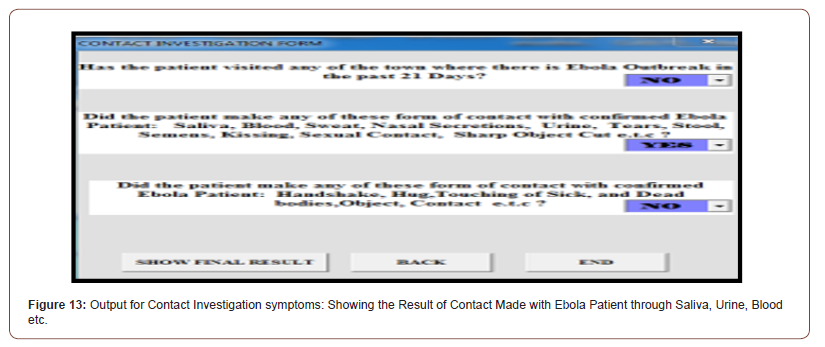
The developed system has been able to make inferences on probable Ebola suspects through the use of investigative pre-coded questions in the knowledge base. Communication between the user and the system is done using the question-and-answer interface. As shown in Figure 3, the system runs with a welcome screen describing the version of Visual Basic Programming language used, the name of the diagnostic system. A prompt is then displayed on the screen in the form of question asking whether a patient is new patient or old patient, as shown in Figure 4. A user form is then displayed on the screen in the form of question about the patient bio data, as shown in Figure 5. The system was able to classify symptoms of Ebola Virus Disease (EVD) into three: the early symptoms, the intermediate symptoms and the advanced systems. A prompt is then displayed on the screen in the form of question as presented in Figure 6. The inferences are made based on the input responses by the user, which is in the form of ‘Yes’ and ‘No’ responses that is Mild, Severe, and Nil as shown in Figure 8.
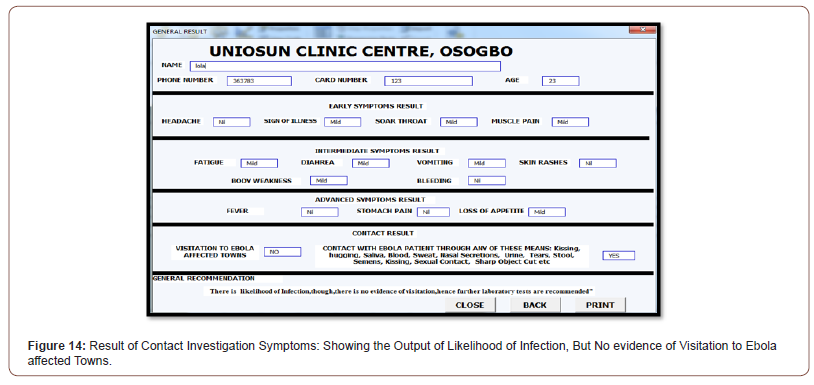
The rate of Ebola transmission can be reduced with the use of the Ebola diagnosis system. The test cases showed reliable inferences from different scenarios. The system showed that reduction in person-to-person transmission of Ebola virus disease can be achieved if probable suspects are identified and diagnosed on time using computer applications that eliminates physical contact with suspects (21days) or infected materials such as Kissing, Hugging, Saliva, Blood etc. as shown in Figure 13, infected body such as dead bodies, Hug, touching of sick person e.t.c.as shown in Figure 14 and fluids. With the suspect of Ebola, the Expert System recommends laboratory test for final confirmation of the expert system diagnosis.
Conclusion
The use of Expert Systems in medicine has enhanced the quality of healthcare delivery services by health professionals. Quick intervention and reduced repercussions are the usual visible benefits of a good medical application. Expert System for the diagnosis of Ebola Virus Disease shares this objective. A cost effective and reliable Expert System for EVD diagnosis is a necessity in the fight against its transmissions and mortality rates. The system also promotes effective management of Ebola suspects and patients. The choice of ‘Nil’, ’Mild’ and ‘Severe’ responses make the system simple enough for any user with basic IT knowledge to use, thereby reducing the cost of hiring and training of professionals on how to use the system. Finally, there is no doubt in the size of the system and its impact on the speed of the computer because of the simplicity of the codes.
Acknowledgement
None.
Conflict of Interest
None.
References
- Onisko A, Druzdzel MJ, Wasyluk H (1999) A Bayesian Network Model for Diagnosis of Liver Disorders. Eleventh Conference on Biocybernetics and Biomedical Engineering, pp. 842846.
- Tseng CP, Chan YJ (2014) Overview of Ebola virus disease in 2014. Journal of the Chinese Medical Association: JCMA 78(1):51-5.
- Shuaib F, Gunnala R, Musa EO, Mahoney FJ, Oguntimehin O, et al. (2014) Ebola virus disease outbreak - Nigeria, july-september 2014. MMWR. Morbidity and Mortality Weekly Report 63(39): 867-872.
- World Health Organization (2014) Ebola Virus Disease.
- Rush KG (2014) Ebola: What is it and what are the symptoms? these are the questions you need to ask about the outbreak; more than 3,400 people in west africa have died in the Ebola outbreak.
- H Feldmann, TW Geisbert (2012) Ebola haemorrhagic fever. Lancet 377: 849–862.
- ME Miranda, NL Miranda Reston (2011) Ebola virus in humans and animals in the Philippines: a review. J Infect Dis 204(Suppl. 3): S757–S760.
- Tambo E, Ugwu EC, Ngogang JY (2014) Need of surveillance response systems to combat ebola outbreaks and other emerging infectious diseases in african countries. Infectious Diseases of Poverty 3: 29.
- Currie J, Grenfell B, Farrar J (2016) Infectious diseases. Beyond Ebola Science 351: 815-816.
- Centers for Disease Control and Prevention (2014) Ebola (Ebola Virus Disease).
- Bruce Arroll, GM Allan, C Raina Elley, Tim Kenealy, James McCormack, et al. (2012) Diagnosis in primary care: probabilistic reasoning. Of Primary Health Care 4(2):166-73.
- Fred A, Filipe J, Partinen M, Paiva T (2000) PSG-Expert - An Expert System for the Diagnosis of Sleep Disorder. Studies in Health Technology and Informatics, pp. 127-147.
- Wiriyasuttiwong W, Narkbuakaew W (2009) Medical Knowledge-Based System for Diagnosis from Symptons and Signs. International Journal of Applied Biomedical Engineering 2(1): 54-59.
- Abu-Naser S, El-Hissi H, Abu-Rass M, El-khozondar N (2010) An Expert System for Endocrine Diagnosis and Treatments Using JESS. Journal of Artificial Intelligence 3(4): 239-251.
- Hassan MA, Sher-E-Alam KM, Chowdhury AR (2010) Human Disease Diagnosis Using a Fuzzy Expert System. Journal of Computing 6(2).
- Borgohain R, Sanyal S (2012) Rule Based Expert System for Cerebral Palsy Diagnosis. 1: 4-6.
- Tunmibi S, Adeniji O, Aregbesola A, Dasylva A (2013) A Rule Based Expert System for Diagnosis of Fever. International Journal of Advanced Research 1(7): 343-348.
- Oguntimilehin A, Adetunmbi AO, Olatunji KA (2014) A Machine Learning Based Clinical Decision Support System for Diagnosis and Treatment of Typhoid Fever. International Journal of Advanced Research in Computer Science and Software Engineering 4(6): 961-969.
- Williams SO, Olatunji OM (2013) Hybrid Intelligent System for the Diagnosis of Typhoid Fever. Journal of Computer Engineering & Information Technology 2(2): 2-9.
- Baden LR, Kanapathipillai R, Campion EW, Morrissey S, Rubin EJ, et al. (2014) Ebola - an ongoing crisis. N Engl J Med 371(15):1458–1459.
- Baize S, Leroy E, Georges A, Georgescourbot MC, Capron M, et al. (2002) Inflammatory responses in Ebola virus infected patients. Clin Exp Immunol 128(1):163-168.
- Brown CE (1993) Introduction to Artificial Intelligence and Expert Systems. Oregon State University, USA.
- Gostin LO, Lucey D, Phelan A (2014) The Ebola Epidemic: A Global Health Emergency. JAMA 312(11):1095-1096.
- Prasadl BC, Krishna Prasad PE, Sagar Y (2011) An approach to develop expert systems in medical diagnosis using machine learning algorithms(asthma) and a performance study. International journal on soft computing, pp. 26-33.
- Russel SJ, Norvig P (2003) Artificial Intelligence - A Modern Approach. Pearson Education Inc.
- Wiegerinck W, Kappen B, Burgers W (2010) Bayesian Networks for Expert Systems, Theory and Practical Applications. Interactive Collaborative Information Systems, pp 547-578.
-
Adekunle M Ibrahim, Selimot Adekanye. Design and Implementation of Intelligent System for Detection and Analysis of Ebola Disease. Glob J Eng Sci. 7(5): 2021. GJES.MS.ID.0006743.
-
Ebola virus, Expert system, Machine learning, Intelligent system, disease detection
-

This work is licensed under a Creative Commons Attribution-NonCommercial 4.0 International License.






